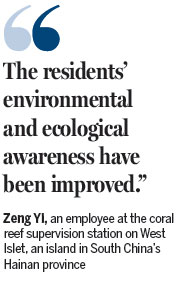Sanya learns how to be eco-friendly
Updated: 2015-10-08 07:47
By Huang Yiming and Liu Xiaoli in Haikou(China Daily)
|
||||||||
As tourism expands, residents start new businesses to serve a wave of visitors
The clear water, soft sand and extensive coral beds around Sanya Bay's West Islet are a natural tourist attraction, buoyed by fishing, sailing and diving that capitalize on a richly diverse undersea world.
Not long ago, though, construction, pollution, trawling fishermen and a dependence on sales of coral handicrafts endangered the coastline ecology of Hainan province and the island community's livelihood.
Conservation campaigns by residents, businesses and the local government successfully helped manage the many threats, restore the coral reefs and further establish tourism as an eco-friendly employer and attraction for visitors.
Public and private investments continue. Recently, the Sanya government announced a plan to invest 556 million yuan ($87 million) to improve the Sanya River water quality, control land-based pollution sources and add more sewage treatment plants.
The Blue Ribbon Ocean Conservation Society, based in the resort city of Sanya, last year organized several large marine protection projects, including a beach rubbish cleanup, public lectures on marine environment protection, and volunteer recruitment to assist with coastline inspections and monitoring.
West Islet, about 14 km from Sanya by ferry, is the second-largest island in Hainan province. It covers an area of 2.8 square kilometers, is home to more than 4,000 permanent residents and has been inhabited for more than 400 years.
Tourism on the island has been operated by Sanya West Island Tourism Development Co since 2001 and has seen rapid growth since then, including the development of eco-friendly tourism activities that attract thousands of tourists annually.
Diving is one of the most popular activities, offering colorful coral reefs, tropical fish and undersea creatures. The island is one of three sections of Sanya National Coral Reef Nature Reserve, an 85 sq km reserve established in 1990 that also includes Yalong Bay and Luhuitou Peninsula-Yulin Bay. The reserve mainly protects the coral reef ecosystem, with its 110 species, and marine biodiversity.
The coral reef coverage around West Islet has increased from a little more than 17 percent in 2005 to nearly 19 percent today.
"Tourism developed on West Islet has enabled local residents who used to be fishermen to change their professions. More than 800 residents have become tourism workers. Some of them make a living by running small businesses, such as selling food, sea shells, coconut handicrafts or swimwear to tourists. Some of them became employees of the tourism company," said Zeng Yi, who lives on the island and works at the coral reef supervision station.

Zeng and his colleagues are ever vigilant in their efforts to protect the reef. They patrol the waters, drive fishing boats from anchoring in prohibited areas and prevent fishermen from trawling. They've also seen residents change their relationship with the sea.
"The residents' environmental and ecological awareness have been improved," Zeng said.
Wang Junjie, deputy director of the reserve administration, said protection efforts, including public education, have helped the reef system to recover.
In the 1960s, coral reef coverage in Sanya waters reached 80 percent. It fell sharply in the 1980s and 1990s, as neither government nor residents had a keen awareness of the value of environmental protection.
Houses on the island were built with coral, residents excavated coral reefs to make handicrafts to sell to tourists and fishing damaged the coral reefs.
"Large marine engineering construction is a deadly threat for the coral reefs in the reserve area. In addition to that, land-based pollution and tourism, such as improper diving activities, are the main threats," said Fu Jie, director of the reserve's administration.
The provincial government has introduced laws to protect the coral, and enhanced punishments for violators are expected. Currently, the most severe punishment for damage to the coral reef is a 100,000 yuan fine.
Contact the writers at liuxiaoli@chinadaily.com.cn
|
A family of tourists enjoy their leisure time on a reef in Sanya, Hainan province, in January. Chen Gang / for China Daily |
(China Daily 10/08/2015 page7)
- Robot monk with artificial intelligence makes debut
- Nursing homes, more Chinese old people's final choices
- Hit-and-run luxury car driver detained in Beijing
- Park officials say glass cracks don't affect walkway's safety
- China becomes smaller for tourists
- Scenic spots packed with tourists on National Day Holiday
- Russian warplanes hit IS targets in Syria
- Senior US envoy to visit Japan, S Korea, China
- Russia, US agree to cooperate in solving Syria crisis: Russian FM
- Iranian President calls Iran deal victory over war
- LatAm experts praise Xi on yuan, globalization
- Evidence found of summertime water flows on Mars: study

 News you don't wanna miss over the National Day holiday
News you don't wanna miss over the National Day holiday
 TCM knacks to fight post-holiday syndrome
TCM knacks to fight post-holiday syndrome
 Zhang Lei wins fourth season of Voice of China
Zhang Lei wins fourth season of Voice of China
 Travel rush around China as National Day holidays end
Travel rush around China as National Day holidays end-
 Rising yuan use may lift IMF basket prospects
Rising yuan use may lift IMF basket prospects 
 China wins first Nobel in medicine
China wins first Nobel in medicine-
 Gary Locke: Candor key to relations
Gary Locke: Candor key to relations -
 Saving Chinese folk songs
Saving Chinese folk songs
Most Viewed
Editor's Picks

|

|

|

|

|

|
Today's Top News
Tu first Chinese to win Nobel Prize in Medicine
Huntsman says Sino-US relationship needs common goals
Xi pledges $2 billion to help developing countries
Young people from US look forward to Xi's state visit: Survey
US to accept more refugees than planned
Li calls on State-owned firms to tap more global markets
Apple's iOS App Store suffers first major attack
Japan enacts new security laws to overturn postwar pacifism
US Weekly

|

|









